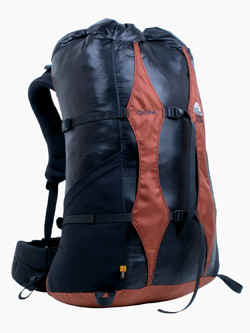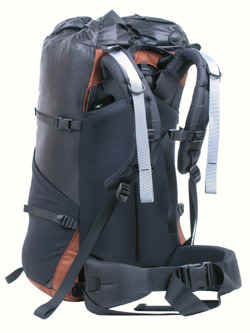

The Granite Gear Nimbus Ozone Pack


The Nimbus Ozone Pack. Right away you can see there is something different about this pack. To find out what, read on...
Nimbus Ozone
The Company Line: "This full-suspension, 3800 cubic inch pack weighs less than 3 lbs and allows you to carry 40-pound loads in amazing comfort, thanks to our 3D molded composite Tepex « frame and our ergonomically designed harness system. Are you the backpacker who has made a conscious decision to reduce your pack weight, but you still like a storm & bug proof shelter? Do you still want to cook up some gourmet cuisine and maybe have a couple shots of your favorite libation at the end of a long day? If 35 to 40 pounds just seems to be as light as you can get, this is your pack. New for 2004: internal hydration sleeve and port."Nimbus Ozone Review
This last year I reviewed several light packs under various conditions. I do not classify myself as a "lite-packer", but I am aiming to keep my loads for a week-long trip under 40 pounds. One of the first places to cut weight is the pack, particularly because my trusty Dana weighs in at 8+ pounds, and that is being generous. So, ideally (at least for the current backpack technology), I am looking at packs that are in the four pounds or less range and over 3200 cubic inches. The real monkey with a wrench is those silly bear canisters, the bane of light-packers, mountaineers, rock-climbers and experienced backpackers. For my evaluations, I am leaving the bulky, awkward, heavy, hard to pack bear canisters out of the equation.The Criteria: A rugged pack that is four pounds or less with adequate appointments that can carry 40 pounds in comfort.
At about 3 pounds, the Granite Gear Nimbus Ozone falls easily into my evaluation criteria for a backpack. It is very well built and rugged enough for most any kind of trip except possibly severe winter conditions or very evil cross-country with plenty of bush. The main sleeve material may not be able to stand up to sharp rocks and pointed sticks like some of the heavier materials of heavier packs (but light packs mean lighter materials). The bottom of the pack and the side sleeves are made of heavier material, and greatly add to the pack durability. Mainly, the pack should hold up very well under normal wear.
The pack is advertised as 3800 cubic inches, but that is a very conservative stat. You could easily drop a 1957 Buick into this spacious pack, and it has more room for bulk than you will ever need. The sleeve and sack fully extended is over three and a half feet long. It is plenty wide so you will have no trouble dropping in sleeping bags and tents. In fact, it is as wide or wider than most larger packs, particularly at the bottom where you need it.
One of the first thing you notice when you lay eyes on this pack is what it does not have. This pack is a sack and harness and little else. This pack was designed purposely to be just what you see, but lets examine it they made the right decisions.
Back when I started backpacking, I designed my own hydration system, and I should have sold my designs. After a while, others learned what I already knew, and perfected their own hydration systems, the current peak being the camel packs with their convenient water tubes. Nowadays, a pack that does not take a hydration system into account is considered passÚ. The model I am reviewing here did not have a hydration sleeve
and port, however the new models do have an internal hydration sleeve and port. This is a very good thing and resolves my major complaint of omission. The only quibble I have is that they put the hydration sleeve inside the pack where it can be crushed by tightly packed gear that could possibly rupture or puncture the water bladder. I would rather they had extended one of the outer side pockets into a hydration sleeve. Actually, the side sleeves go pretty high (adding to the durability of the pack), and could probably carry one of the smaller water bladders quite well. For my test-drive with the Nimbus Ozone, I had to attach a long Dana side-pouch that would hold my water bladder. None of that will be necessary for the new models of this pack.Another thing this pack does not have is a traditional pack lid, which also serves as a compressor. What it does have is a very long sack sleeve with straps. After you have packed everything away, you close the sack with a draw chord just like most packs, then roll up the excess sleeve and cinch it down with the handy straps. This actually works fairly well, and probably will keep out moisture better than traditional packs. If it rains or snows, water may collect where you have rolled up the sleeve, but it would be a small matter of brushing away this moisture as you unroll the sleeve. Considering the length of the whole sack and the straps, I do think they could of shortened the sleeve and added a light-weight single compartment compressor pack lid at no additional weight. I find that traditional top pack lids to be too darned convenient, particularly for rest breaks, and a handy place to keep close at hand the toilet paper and plastic shovel. I must stress that this is a personal preference, and if you have a mind to, one could easily adjust to not having a top lid.
The pack does have two ice-axe loops at the bottom of the pack, and one of the mid-line or side straps could be adjusted to keep the axe handles in place. Ice-axes kind of defeats the purpose of packing light, so you may, like me, find other uses for the loops, like attaching a camp chair.
The harness is well made with S-Curve shaped straps (a requirement these days) and a hip-cupping well padded hip belt. I had no trouble attaching my Dana side pouch to the harness. The shoulder straps each have a ring where you can insert the hydration tube and top straps, a very nice touch. All the straps have their ends looped and sewn, another touch of quality and attention to detail. The harness is adjustable and comes in different sizes. The one I reviewed had a hip belt that was a little too large, but still it was a minor detail. I could get a smaller hip belt.
If you order this pack, you can choose the frame-sheet size (short, for 14" to 18"; or regular, for 18" to 22"), hip belt size (small, medium, large, x-large, and 2x-large for either men or women), and shoulder straps (trim or regular) and in multiple sizes (small, medium, large, and x-large).This pack is not a technical pack, but other than the points I mentioned above, I did not miss the extra pouches, straps, loops and other details that come with technical packs.
The last question, is how is the ride? How is the comfort level? My standard for comfort is my Dana pack which can carry any weight in comfort and has a harness system that embraces you like an old lover. I have notice that with all small packs I have tried, most of the weight concentrates on a small area of the back so that when the weight reaches a certain point it gets uncomfortable. That is because the weight is concentrated on so small an area of pressure, it can cause pressure and wear points on the back. The Dana on the other hand distributes the weight pressure over a large area of the back and around the hip belt, dramatically raising the comfort level and its ability to carry large loads in comfort.
What I learned about the Nimbus Ozone was that there is a dramatic shift in comfort level from a pack weight of 35 pounds to 40+ pounds. At 35 pounds the pack is very comfortable, and one of the best rides of the many smaller packs I have tried out. Every pound over 35 pounds decreases the comfort level to the point that when the load reaches 40 pounds, any more weight crosses the pack over into the uncomfortable zone, and gets worse with every pound. The weight pressure on the back is distributed over a wider area than most small packs, but still not as wide a surface area as the Dana (which is understandable).
On a trip I field-tested this pack, I started out at about 42 pounds (the water and food weight being the big factor). The fit and weight was manageable even though I was constantly adjusting the straps till I drank most of the water (thereby reducing the weight) and reached a certain comfort level. I noticed at the higher weight levels, the tops of the shoulder straps were pressing into my back just enough to be annoying (and may be an area that the pack design could be improved). All problems disappeared when the weight dropped below 40 pounds. By the end of the trip and the pack was down to about 35 pounds and the comfort level was just about as good as any pack out there, and in fact was indeed very comfortable.
Pros: The Nimbus Ozone is a top loading
pack under 3 pounds with more room than you will ever need. A minimalist pack with a high comfort level for its size and weight. It is very adjustable and comes in different sizes. The pack compress loads very well. The workmanship and quality of the pack is outstanding. The newest version of the pack has a hydration sleeve. Weight concentrates over a small area of the back, but a larger area than most small or light packs.Cons: The Nimbus Ozone may be a little too minimalistic for some, and they may miss the top lid and outer pouches of traditional packs. The ideal total carrying weight seems closer to 35 pounds than 40. Getting the ideal fit may take some work.
Bottom Line: Granite Gear says, "If 35 to 40 pounds just seems to be as light as you can get, this is your pack.". I would have to agree, with the stipulation that the comfort level drops off dramatically every pound over 35 pounds. If you like packs without the extra buzzers and bells and you can keep your loads between 35 and 40 pounds or less, this may be the perfect pack for you.